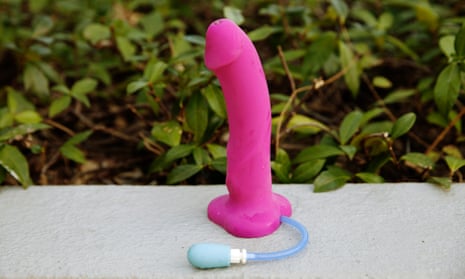I have seen a roomful of people recoil – for purely aesthetic reasons – from a marijuana leaf decal on a sex toy. I have met a venture capitalist who tried out 297 sex toys and yet still argued passionately for diamantes on vibrators despite a chorus of “but what if they fall off?”
I’ve heard that a toy designed like a lily is good, but one that is designed like a butterfly is bad – but I still don’t know why that is.
I’ve learned that big buttons aren’t just useful for elderly people’s phones, but also for elderly people’s vibrators.
I’ve heard young women talk about how they want sex shops to look more like Aesop or the Genius Bar than the Club X on Elizabeth Street, and sum up 90% of the population when they said their target market was “the curious and the confused”.
I was overcome with a weary late-capitalism-always-optimising feeling when a group unveiled a FitBit-style app that encouraged you to masturbate and tracked the frequency and duration of your “sexual self-care” – and sent you notifications and reminders when like, you know, it’s been been a while.
I have seen and held an array of merch that ranged in shape from a poached egg to a terrifying tower of black silicon with claws (called the Greedy Girl).
I have been in a room where an Arnott’s biscuit tin was mooted as a possible design solution for nostalgia-loving boomers who want to charge and store their sex toys in a discreet place in their nursing home.
I’ve learned what a dental dam is and that they have nothing to do with dentists … or dams.
In short – I’ve seen the future of sex toys – and been amazed.
This month I hung out for two days with about 60 participants (90% of them women) who spent 48 hours in small groups coming up with what I can only describe as “innovative product solutions” for a range of sexual situations.
These include helping design a product for an ageing – and possibly arthritic population – who might be in nursing homes, creating a product for women on the menopause spectrum who need greater sensation, designing realistic sex ed for kids through gaming, a VR product to help young men learn about consent and creating a sex shop that isn’t seedy.
The hackathon was last held two years ago in Sydney and the winner was a voice-activated vibrator.
This year’s winner was a group of women who designed a sex ed game for eight-to-13-year-olds.
The conference – in a swanky inner-Melbourne co-working space above a shopping centre – kicked off on Saturday morning with participants watching the dissection of a sex toy, before splitting into teams.
So what goes into the design of a sex toy?
In the room where a sex toy was being created for women on the menopause spectrum, people come in and out offering kombucha, while others debated the product’s colour.
No one wanted the device to be pink.
One woman who runs an online sex shop said: “The most common colours I sell are purple, black, teal and white.”
“I do really like the light blue,” said another woman looking at mock-ups on a screen. “Not too floral, something abstract, modern and simple. We have to get away from the middle-aged women narrative of floral and pink, like a box of tampons.”
The venture capitalist who tried 297 sex toys (“My housemate came into my room one day and went ‘OMG’ when she saw them all”) discussed the products she tried and she didn’t like; “I tried vibrating panties, they didn’t look very nice. They were very BDSM-looking, red and black. And then I went for a walk and thought about design and then a ladybird landed on my arm and I thought – ah yes ... something should be designed to look like a ladybird!”
After the aesthetics were discussed, the lone guy in the room pitched in about practicalities. “What about battery density?” he asked. “Where’s the battery going to sit?”
Other design and practical issues included how to charge the device, what material to use and how it could be used by both the right and left-handed.
I left them to it and wandered around the space, sitting in with teams, sometimes breaking the fourth journalist wall to offer unsolicited advice and make terrible jokes.
I told the sex shop group that the space should be somewhere “where you can be vulnerable”.
Another team was coming up with a box or a kit of masturbation aids.
But what to call it? Something naughty, but nice, something … memorable.
“You should call it Go Fuck Yourself,” I blurted out. In the silence I could sense they felt embarrassed for me. (The team went with the name “You Are a Universe” because “Everyone should be explored and we want people to experience pleasure throughout their lifetime.”)
Even though the sex tech industry is booming, there are still some pockets of reserve.
Two of the men from You Are a Universe had gone down to the shopping centre to survey a range of shoppers (age 17 to 72) about whether they would buy the box.
“No one would buy it for themselves, but they said they would buy it for others,” said the team member.
The sex tech industry is growing fast – it is worth $30bn as of 2020 – while the sexual wellness industry at large is forecast to hit $122.6bn by 2026.
The founder of the event Bryony Cole, says: “Things are changing in terms of the public’s attitude to sex toys and technology. Factors include Goop and the wellness industry.”
By aligning sex and masturbation with the wellness industry, Cole believes that sex toys will come out of darkened, old-school sex shops and into the mainstream.
The sex toys, games and kits hadn’t even been made yet and they were already bringing people a lot of joy. As I walked in and out of each team’s room, the cries of “Yes, yes, yes!” were ringing out as the group lit on great ideas.
They just need to hurry up and make them.

